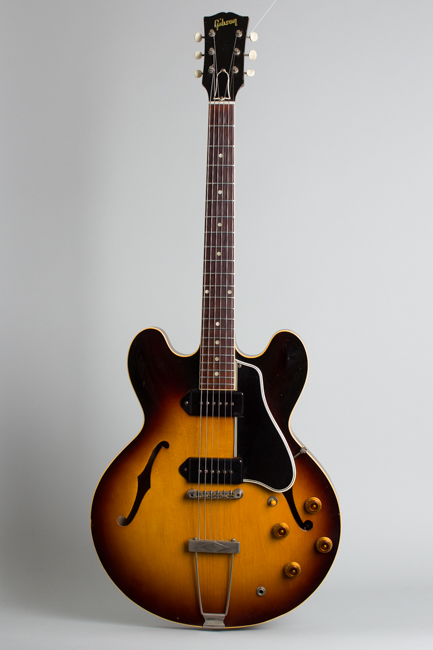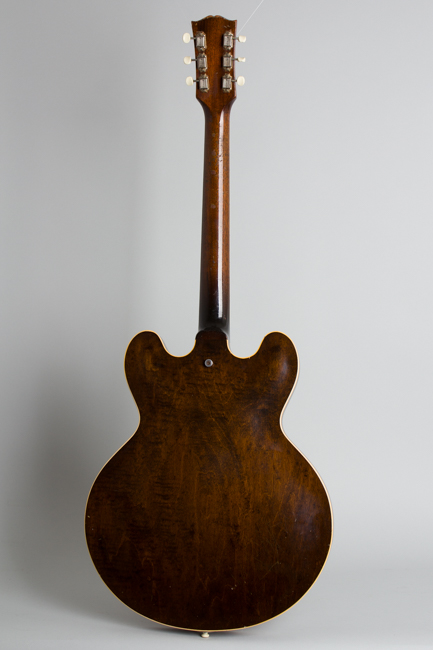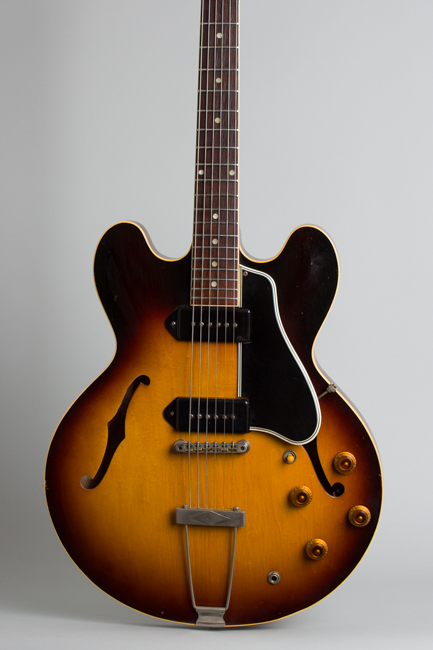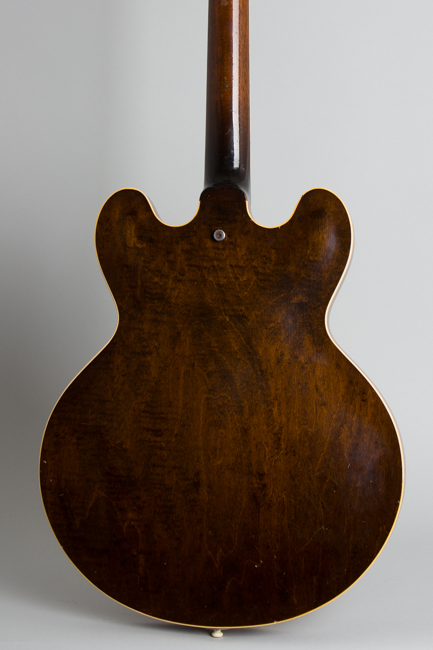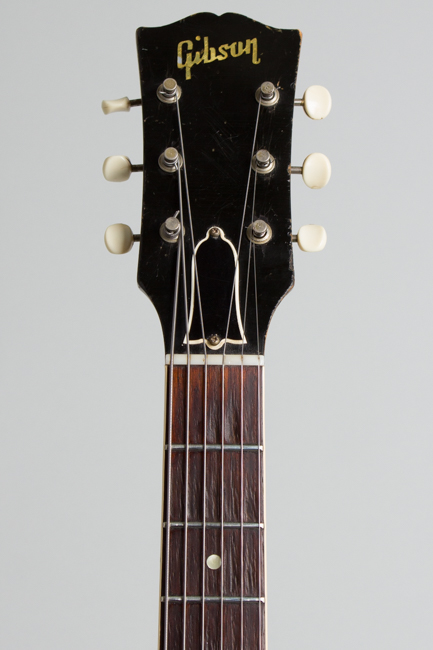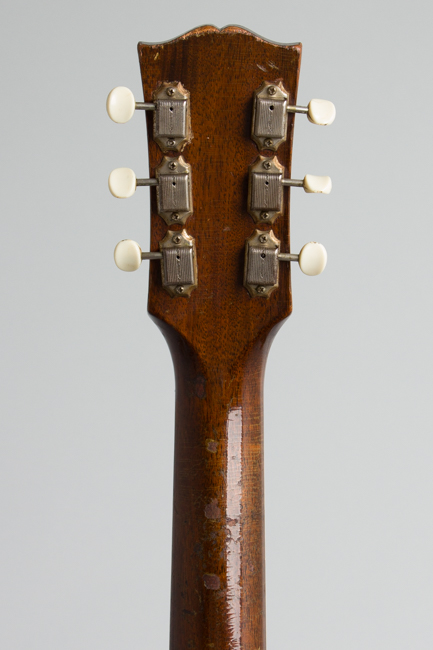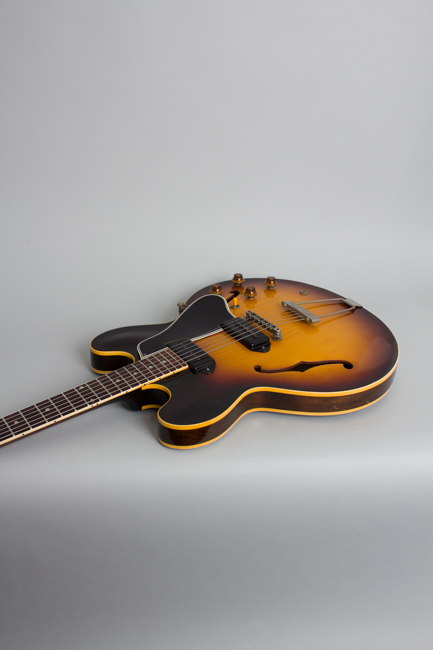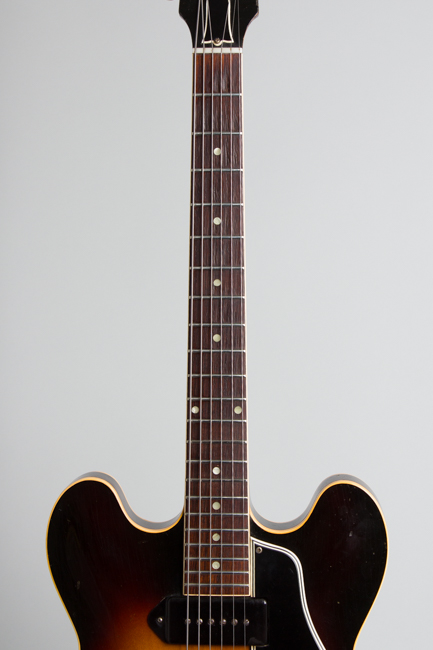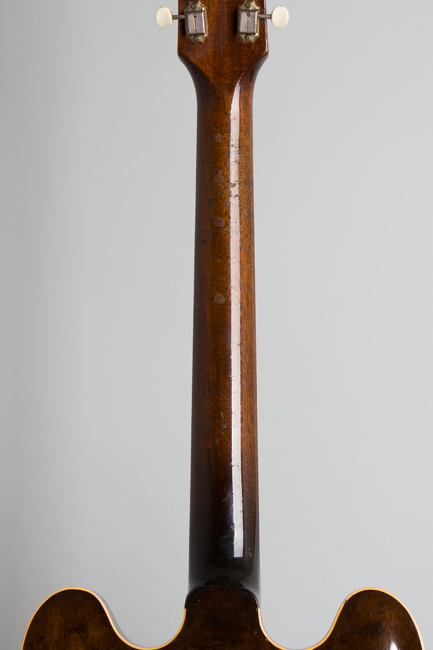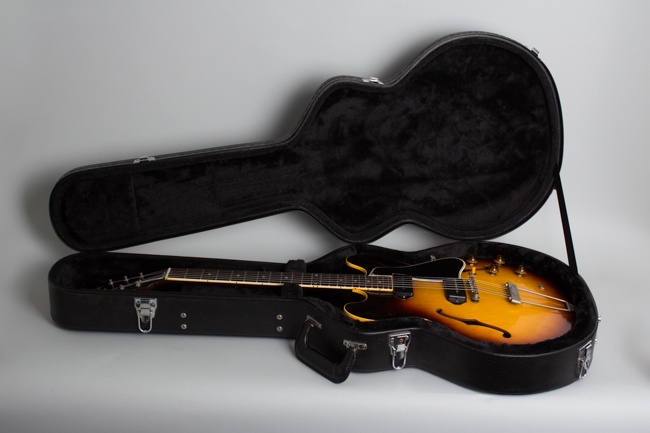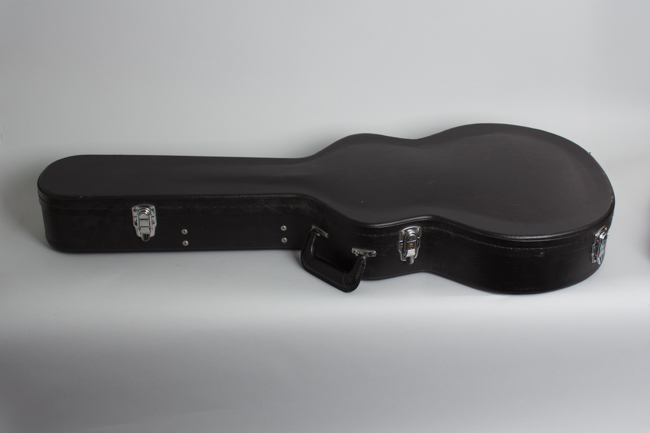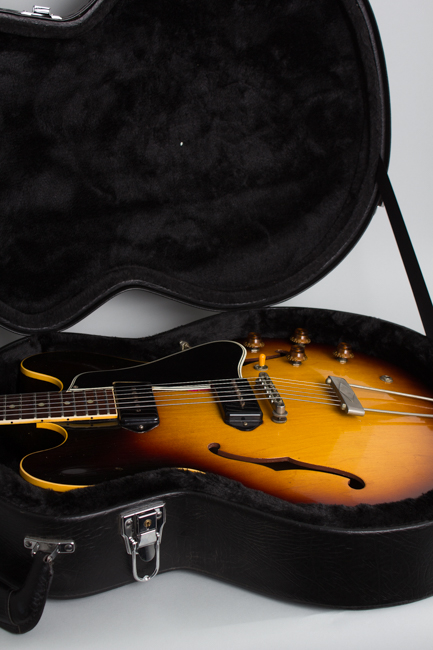Gibson ES-330TD Thinline Hollow Body Electric Guitar (1959)
This item is currently on hold.
Item # 12433
Prices subject to change without notice.
Gibson ES-330TD Model Thinline Hollow Body Electric Guitar (1959), made in Kalamazoo, Michigan, serial # S1033-33 (FON), sunburst top, dark back and sides finish, laminate maple body, mahogany neck, rosewood fingerboard, black tolex hard shell case.
This is a somewhat played-in example of a very early first-generation sunburst Gibson ES-330TD from 1959, the model's debut year. This guitar has all the earliest features including a bound dot-inlaid rosewood fingerboard, rounder "Mickey Mouse" cutaway horns and black plastic P-90 pickup covers. The 1959-coded factory order number (S1033-33) under the treble side F-hole indicates an extremely early batch of this then brand-new model, possibly the first rack in production; we have also had identical ES-330s from the sequential FON batch 1034.
Although debuted in 1959 ES-330 models were not available to dealers until the fall of that year. The initial announcement was in the October/November '59 GIBSON GAZETTE describing them as "Thrilling modern instruments" adding "Double cutaway body and thin silhouette make it wonderfully east to hold and play". They are pitched as replacing the ES-225 series, Gibson's first economy thinlines "within the next few weeks" indicating shipments of the 330's had just gotten underway. A total of 270 sunburst two-pickup models made it out of Kalamazoo before the end of the year priced at $250 (plus case) of which this is one.
This ES-330 has a classic set of mid-line Gibson features, but a distinctive feel. While grouped with the semi-solid 335 range it is actually a very different instrument to play. The slim single-bound body is fully hollow without a center block, making it much lighter than the 335-355 series. This also resulted in another distinguishing feature of the 330, the neck joining the body farther in at the 16th fret to allow the joint to be stronger. The twin P-90 pickups are mounted under black plastic dog-ear covers, which would be replaced with metal in the early '60s. They are controlled by the standard Gibson 4-knob one switch wiring rig.
This guitar's neck profile is the rounder "59 style" that Gibson used at this time; it is not as chunky as some but has a comfortable round backed feel. The bulk of dot-neck ES-330s shipped in 1960 and '61 were made with the much flatter 1960 profile, which some players are not as fond of, so these chunkier '59 necks are a much rarer breed. The headstock has a pearl Gibson logo; the tuners are single-unit enclosed Kluson deluxe with plastic buttons.
Early ES-330TDs are great-sounding, extremely versatile guitars and have been heard in many styles of music since the instrument was introduced. Jazz great Grant Green used this model extensively on his well-regarded early 1960s recordings. Slim Harpo relied on one for his deep swamp blues. The 330 and its nearly identical sister guitar the Epiphone Casino were featured in countless '60s British invasion bands, including the Beatles, Rolling Stones, Kinks, Manfred Mann, and many more. This is a super example, one of the vert the earliest ES-330TDs we have seen, light and handy with a killer feel and sound.
Overall length is 39 3/4 in. (101 cm.), 16 in. (40.6 cm.) wide at lower bout, and 1 3/4 in. (4.4 cm.) in depth, measured at side of rim. Scale length is 24 3/4 in. (629 mm.). Width of nut is 1 11/16 in. (43 mm.).
Overall this is a largely original guitar showing some fairly typical wear but no major damage or repair. It remains original except for the knobs and switch tip, which are correct style repros. The all-original finish is mostly relatively clean with typical checking, some scuffing and small dings. This is mostly noticeable on the back of the neck which has some feelable dinks to the wood up to the 5th fret and wear along the treble edge. The back of the body shows some belt-buckle scratching into but not through the lacquer. The edges of the headstock are a bit banged up with a some flaking and chipping to the face.
A correct vintage Gibson strap button was added on the back of the heel, lower than we would normally expect but still useful. ES-330s lacked this useful feature for some years, and nearly all have since been fitted with one. The remaining hardware is original, showing light typical wear. A couple of the tuner shafts are lightly bent but all are functional. The original frets have recently been dressed and play well; there is some noticeable divoting to the fingerboard in the lower positions. Well loved but not too heavily worn in this is a fine playing and sounding guitar, very light and super comfortable with a bit of mojo about it. It is housed in a modern HSC. Overall Excellent - Condition.
This is a somewhat played-in example of a very early first-generation sunburst Gibson ES-330TD from 1959, the model's debut year. This guitar has all the earliest features including a bound dot-inlaid rosewood fingerboard, rounder "Mickey Mouse" cutaway horns and black plastic P-90 pickup covers. The 1959-coded factory order number (S1033-33) under the treble side F-hole indicates an extremely early batch of this then brand-new model, possibly the first rack in production; we have also had identical ES-330s from the sequential FON batch 1034.
Although debuted in 1959 ES-330 models were not available to dealers until the fall of that year. The initial announcement was in the October/November '59 GIBSON GAZETTE describing them as "Thrilling modern instruments" adding "Double cutaway body and thin silhouette make it wonderfully east to hold and play". They are pitched as replacing the ES-225 series, Gibson's first economy thinlines "within the next few weeks" indicating shipments of the 330's had just gotten underway. A total of 270 sunburst two-pickup models made it out of Kalamazoo before the end of the year priced at $250 (plus case) of which this is one.
This ES-330 has a classic set of mid-line Gibson features, but a distinctive feel. While grouped with the semi-solid 335 range it is actually a very different instrument to play. The slim single-bound body is fully hollow without a center block, making it much lighter than the 335-355 series. This also resulted in another distinguishing feature of the 330, the neck joining the body farther in at the 16th fret to allow the joint to be stronger. The twin P-90 pickups are mounted under black plastic dog-ear covers, which would be replaced with metal in the early '60s. They are controlled by the standard Gibson 4-knob one switch wiring rig.
This guitar's neck profile is the rounder "59 style" that Gibson used at this time; it is not as chunky as some but has a comfortable round backed feel. The bulk of dot-neck ES-330s shipped in 1960 and '61 were made with the much flatter 1960 profile, which some players are not as fond of, so these chunkier '59 necks are a much rarer breed. The headstock has a pearl Gibson logo; the tuners are single-unit enclosed Kluson deluxe with plastic buttons.
Early ES-330TDs are great-sounding, extremely versatile guitars and have been heard in many styles of music since the instrument was introduced. Jazz great Grant Green used this model extensively on his well-regarded early 1960s recordings. Slim Harpo relied on one for his deep swamp blues. The 330 and its nearly identical sister guitar the Epiphone Casino were featured in countless '60s British invasion bands, including the Beatles, Rolling Stones, Kinks, Manfred Mann, and many more. This is a super example, one of the vert the earliest ES-330TDs we have seen, light and handy with a killer feel and sound.
Overall length is 39 3/4 in. (101 cm.), 16 in. (40.6 cm.) wide at lower bout, and 1 3/4 in. (4.4 cm.) in depth, measured at side of rim. Scale length is 24 3/4 in. (629 mm.). Width of nut is 1 11/16 in. (43 mm.).
Overall this is a largely original guitar showing some fairly typical wear but no major damage or repair. It remains original except for the knobs and switch tip, which are correct style repros. The all-original finish is mostly relatively clean with typical checking, some scuffing and small dings. This is mostly noticeable on the back of the neck which has some feelable dinks to the wood up to the 5th fret and wear along the treble edge. The back of the body shows some belt-buckle scratching into but not through the lacquer. The edges of the headstock are a bit banged up with a some flaking and chipping to the face.
A correct vintage Gibson strap button was added on the back of the heel, lower than we would normally expect but still useful. ES-330s lacked this useful feature for some years, and nearly all have since been fitted with one. The remaining hardware is original, showing light typical wear. A couple of the tuner shafts are lightly bent but all are functional. The original frets have recently been dressed and play well; there is some noticeable divoting to the fingerboard in the lower positions. Well loved but not too heavily worn in this is a fine playing and sounding guitar, very light and super comfortable with a bit of mojo about it. It is housed in a modern HSC. Overall Excellent - Condition.
